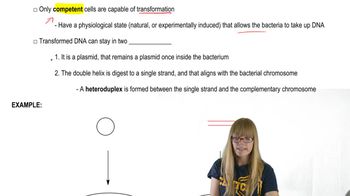How do translocations such as the Philadelphia chromosome contribute to cancer?
Table of contents
- 1. Introduction to Genetics51m
- 2. Mendel's Laws of Inheritance3h 37m
- 3. Extensions to Mendelian Inheritance2h 41m
- 4. Genetic Mapping and Linkage2h 28m
- 5. Genetics of Bacteria and Viruses1h 21m
- 6. Chromosomal Variation1h 48m
- 7. DNA and Chromosome Structure56m
- 8. DNA Replication1h 10m
- 9. Mitosis and Meiosis1h 34m
- 10. Transcription1h 0m
- 11. Translation58m
- 12. Gene Regulation in Prokaryotes1h 19m
- 13. Gene Regulation in Eukaryotes44m
- 14. Genetic Control of Development44m
- 15. Genomes and Genomics1h 50m
- 16. Transposable Elements47m
- 17. Mutation, Repair, and Recombination1h 6m
- 18. Molecular Genetic Tools19m
- 19. Cancer Genetics29m
- 20. Quantitative Genetics1h 26m
- 21. Population Genetics50m
- 22. Evolutionary Genetics29m
19. Cancer Genetics
Overview of Cancer
Problem 19
Textbook Question
Describe the difference between an acute transforming virus and a virus that does not cause tumors.
 Verified step by step guidance
Verified step by step guidance1
Understand that an acute transforming virus is a type of virus that carries an oncogene, which is a gene capable of inducing cancer. This oncogene is often derived from the host cell's genome but has been altered or misregulated by the virus.
Recognize that the oncogene carried by an acute transforming virus can directly interfere with the normal regulation of cell growth and division, leading to uncontrolled cell proliferation and tumor formation.
Contrast this with a virus that does not cause tumors, which typically lacks an oncogene and does not directly disrupt the host cell's growth regulation. These viruses may replicate within the host without inducing cancer.
Note that non-tumor-causing viruses may still cause other types of diseases or remain latent in the host without causing significant harm, depending on the virus's life cycle and interaction with the host's immune system.
Summarize the key difference: acute transforming viruses actively promote tumor formation through the introduction of oncogenes, while non-tumor-causing viruses do not carry oncogenes and do not directly induce cancer.
 Verified video answer for a similar problem:
Verified video answer for a similar problem:This video solution was recommended by our tutors as helpful for the problem above
Video duration:
2mPlay a video:
Was this helpful?
Key Concepts
Here are the essential concepts you must grasp in order to answer the question correctly.
Acute Transforming Viruses
Acute transforming viruses are a type of virus that can induce rapid transformation of host cells, leading to uncontrolled cell growth and tumor formation. These viruses often carry oncogenes, which are genes that can promote cancer when mutated or expressed at high levels. Examples include certain strains of retroviruses that can integrate their genetic material into the host genome, altering normal cellular functions.
Recommended video:
Guided course

Transformation
Non-Tumorigenic Viruses
Non-tumorigenic viruses are those that do not cause cancerous transformations in host cells. These viruses may replicate within the host without altering cellular growth control mechanisms or may cause acute infections that resolve without leading to long-term changes in cell behavior. Examples include many common cold viruses and other pathogens that primarily cause acute illnesses without oncogenic potential.
Recommended video:
Guided course

Non-Random Mating
Oncogenes and Tumor Suppressor Genes
Oncogenes are mutated forms of normal genes (proto-oncogenes) that, when activated, can lead to cancer by promoting excessive cell division or survival. In contrast, tumor suppressor genes normally function to inhibit cell growth and promote apoptosis. The balance between oncogenes and tumor suppressor genes is crucial in determining whether a cell becomes cancerous, highlighting the role of genetic factors in tumorigenesis.
Recommended video:
Guided course

Mapping Genes

 9:51m
9:51mWatch next
Master Cancer Characteristics with a bite sized video explanation from Kylia
Start learningRelated Videos
Related Practice
Textbook Question
667
views
